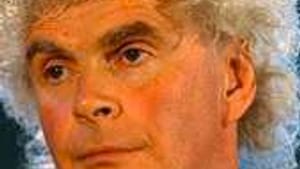Stay in the Loop
BSR publishes on a weekly schedule, with an email newsletter every Wednesday and Thursday morning. There’s no paywall, and subscribing is always free.
Rattle confronts the Grim Reaper
Rattle, the Orchestra and death

Death is beautiful. This proposition, as foreign to Americans as it was to the aristocratic gentry of conductor Simon Rattle's native England, permeated the art and music of late 19th- and early 20th-Century Austria as well as its northern neighbor, Germany. Frederic Morton, in two absorbing books— A Nervous Splendor: Vienna 1888-1889 and Thunder at Twilight: Vienna 1913/1914— painstakingly documented the apogee and precipitous end of a culture that rendered angst and its chief protagonists, decadence and death, into expressions of contemplation and beauty.
Only such a culture could have produced, on the one hand, Mahler's preoccupation with death— as expressed in his "Resurrection" Symphony No. 2 and the Kindertotenlieder—and, on the other hand, the shameless deconstruction of five centuries of musical heritage by Arnold Schoenberg, Alban Berg and Anton Webern.
The latter's revolutionary Six Pieces for Orchestra served in this weekend's Philadelphia Orchestra concert as the striking centerpiece between two staples of the German Romantic tradition, Brahms's Symphony No. 3 in F Major and Schumann's Symphony No. 3 in E-flat Major ("Rhenish").
Recovered fumble
The Brahms Third was composed when Austro-German glory first began to show its tarnish and the end of the Romantic era could be seen on the horizon. Brahms, well aware of the high symphonic standard set by Beethoven, composed his four symphonies with great care, and all are gems of the symphonic repertoire, although they're played so often that they can lose their sense of wonder.
Fortunately, Simon Rattle gave new life to the Third by bringing out nuances, especially in the strings, that are often overlooked. The Orchestra, however, fumbled a few transitional moments and didn't appear well rehearsed.
Rattle made up for this difficulty by beautifully eliciting the shifts of emotion that may have stirred within Brahms during a sojourn along the Rhine. Thus within a generally joyful mood, one could hear a reflective awareness of mortality in the piece's quieter moments.
During his tenure with the Berlin Philharmonic, Rattle appears to have learned much from the German tradition of conducting exemplified by Wilhelm Furtwangler and Carlos Kleiber, evoking emotionality while seeking subtlety throughout a composition. What emerged was a fresh look at Brahms's more introverted side.
Webern's inner grief
Webern was a devoted student of Schoenberg, equally radical in 12-tone and serial composition; and although he was nowhere near as prolific, Webern was possibly a more disciplined composer than his mentor.
His Six Pieces for Orchestra constitute a masterpiece of what would later be called minimalist composition. The sonorities are sparse but beautiful. Not a note is wasted. And the sense of inner grief surrounding the death of the composer's mother came through beautifully, especially under Rattle's baton.
Again, death— but such a different experience from that of Webern's contemporary Mahler. Webern's grief was understated to the point of exquisite self-abnegation.
Before Schumann went mad
By contrast, Schumann's Third ("Rhenish") Symphony is full of life, an adventurous, rich and exciting musical journey that even contains touches of the mythic proportions of the composer's archrival, Wagner. The coherence, joy and boldness embodied in this symphony makes it difficult to imagine that, only a few years later, Schumann would go mad to the point of institutionalization.
This piece, composed during the height of Romanticism, contained absolutely none of the death knell heard in the Webern and, in slight hints, the Brahms. The Orchestra performed it masterfully, with a freshness, enthusiasm and vigor that made it come alive as if it were composed yesterday.♦
To read a response, click here.
Only such a culture could have produced, on the one hand, Mahler's preoccupation with death— as expressed in his "Resurrection" Symphony No. 2 and the Kindertotenlieder—and, on the other hand, the shameless deconstruction of five centuries of musical heritage by Arnold Schoenberg, Alban Berg and Anton Webern.
The latter's revolutionary Six Pieces for Orchestra served in this weekend's Philadelphia Orchestra concert as the striking centerpiece between two staples of the German Romantic tradition, Brahms's Symphony No. 3 in F Major and Schumann's Symphony No. 3 in E-flat Major ("Rhenish").
Recovered fumble
The Brahms Third was composed when Austro-German glory first began to show its tarnish and the end of the Romantic era could be seen on the horizon. Brahms, well aware of the high symphonic standard set by Beethoven, composed his four symphonies with great care, and all are gems of the symphonic repertoire, although they're played so often that they can lose their sense of wonder.
Fortunately, Simon Rattle gave new life to the Third by bringing out nuances, especially in the strings, that are often overlooked. The Orchestra, however, fumbled a few transitional moments and didn't appear well rehearsed.
Rattle made up for this difficulty by beautifully eliciting the shifts of emotion that may have stirred within Brahms during a sojourn along the Rhine. Thus within a generally joyful mood, one could hear a reflective awareness of mortality in the piece's quieter moments.
During his tenure with the Berlin Philharmonic, Rattle appears to have learned much from the German tradition of conducting exemplified by Wilhelm Furtwangler and Carlos Kleiber, evoking emotionality while seeking subtlety throughout a composition. What emerged was a fresh look at Brahms's more introverted side.
Webern's inner grief
Webern was a devoted student of Schoenberg, equally radical in 12-tone and serial composition; and although he was nowhere near as prolific, Webern was possibly a more disciplined composer than his mentor.
His Six Pieces for Orchestra constitute a masterpiece of what would later be called minimalist composition. The sonorities are sparse but beautiful. Not a note is wasted. And the sense of inner grief surrounding the death of the composer's mother came through beautifully, especially under Rattle's baton.
Again, death— but such a different experience from that of Webern's contemporary Mahler. Webern's grief was understated to the point of exquisite self-abnegation.
Before Schumann went mad
By contrast, Schumann's Third ("Rhenish") Symphony is full of life, an adventurous, rich and exciting musical journey that even contains touches of the mythic proportions of the composer's archrival, Wagner. The coherence, joy and boldness embodied in this symphony makes it difficult to imagine that, only a few years later, Schumann would go mad to the point of institutionalization.
This piece, composed during the height of Romanticism, contained absolutely none of the death knell heard in the Webern and, in slight hints, the Brahms. The Orchestra performed it masterfully, with a freshness, enthusiasm and vigor that made it come alive as if it were composed yesterday.♦
To read a response, click here.
What, When, Where
Philadelphia Orchestra: Brahms, Symphony No. 3 in F Major, Op. 90; Webern, Six Pieces for Orchestra, Op. 6; Schumann: Symphony No. 3 in E-flat Major, Op. 97. Simon Rattle, conductor. April 26-29, 2012 at Verizon Hall, Kimmel Center, Broad and Spruce St. (215) 893-1999 or www.philorch.org.
Sign up for our newsletter
All of the week's new articles, all in one place. Sign up for the free weekly BSR newsletters, and don't miss a conversation.

 Victor L. Schermer
Victor L. Schermer